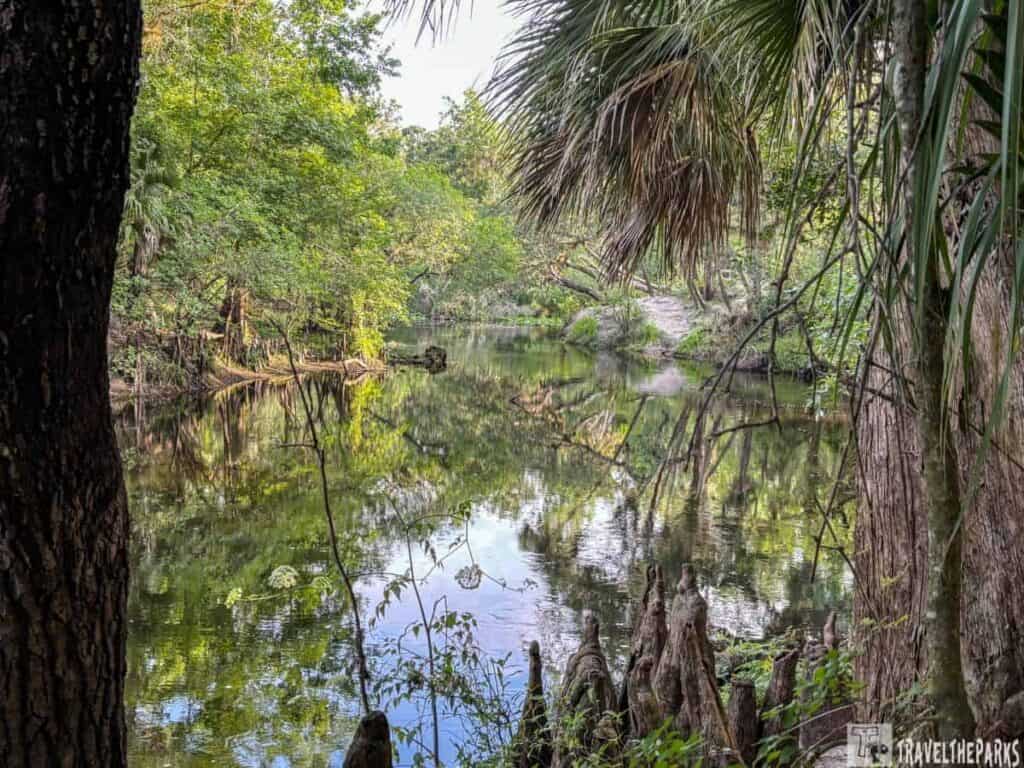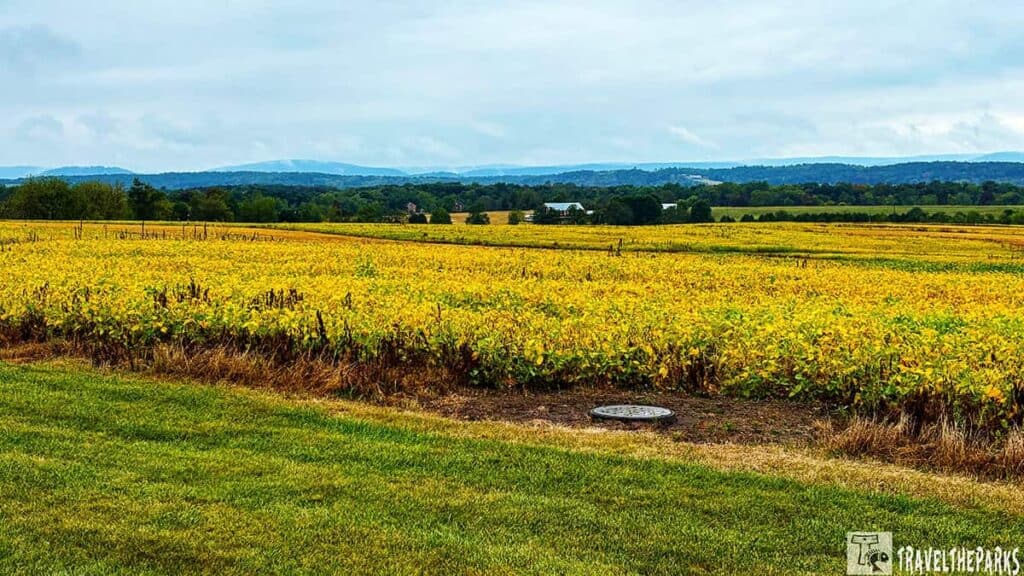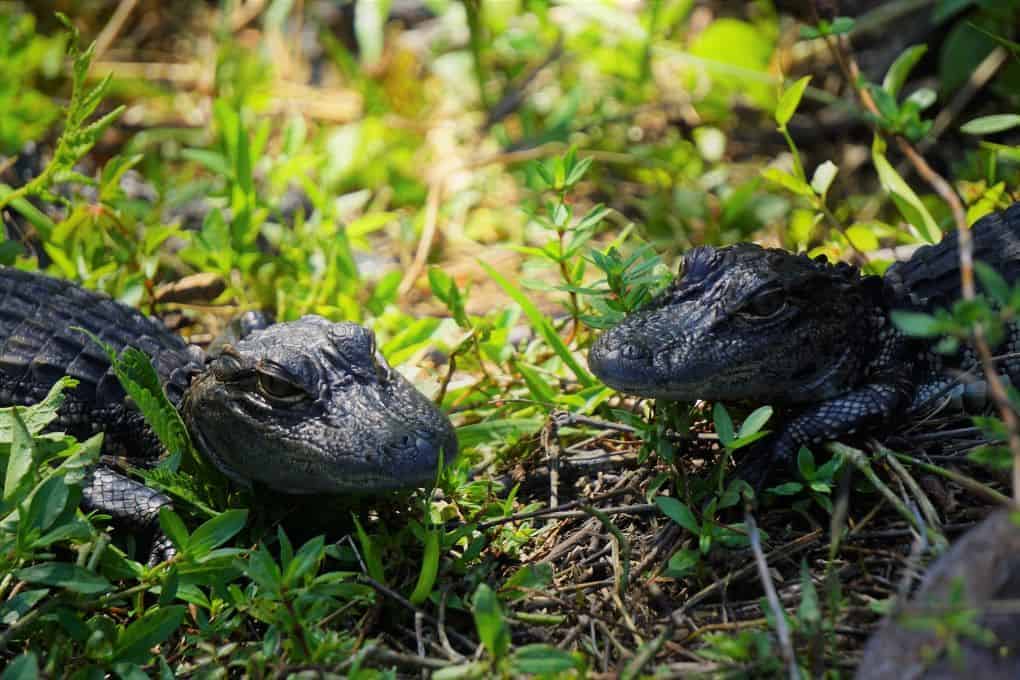If iconic St. Augustine isn’t on your travel bucket list yet, it should be. Legendary for the fountain of youth that Ponce de Leon sought, this city has a well-established history. As the oldest continuously inhabited European settlement in the U.S., St. Augustine is an unforgettable destination.
This post may contain affiliate links, meaning if you purchase something through one of these links, we may earn a small commission at no extra cost to you! Read the full disclosure policy here.
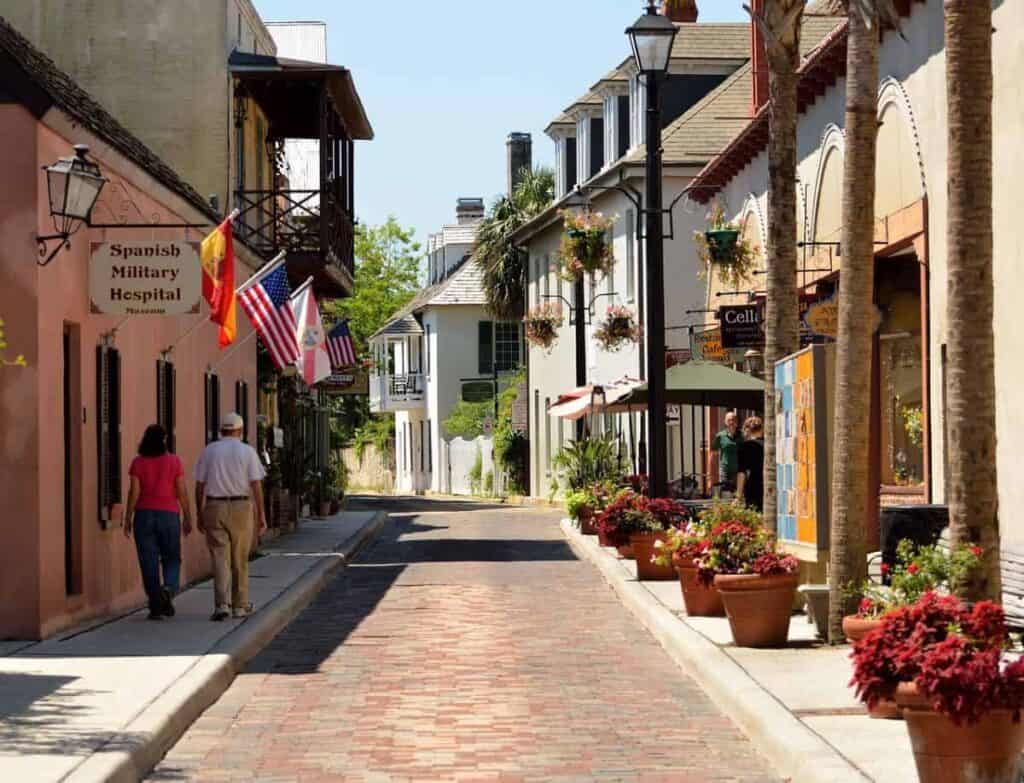
Table of Contents
Traveling to St. Augustine: What You Need to Know
This historic city is less than a 2-hour drive from Orlando in Central Florida, so it was an obvious decision for us to make the drive for a getaway one long weekend. Yet many Floridians never take the time to venture to this Sunshine State locale.
- St. Augustine is easily accessible from the north and south by Interstate 95, U.S. Highway 1, and scenic Florida Highway A1A. Easily accessible from Amelia Island or Daytona Beach via the Buccaneer Trail.
- Best Time to Visit: Spring (March–May) and fall (September–November) offer mild weather and fewer crowds. Summers are hot/humid. Winter is cooler but still pleasant, especially for exploring historic sites.
- Parking: Historic downtown has limited parking—consider the St. Augustine Historic Downtown Parking Facility closest to the Visitor Information Center.
- What to Pack: Comfortable walking shoes (cobblestone streets!) Sunscreen, sunglasses, and a hat, especially in summer. A light jacket in winter or rain gear for any season. Reusable water bottle for staying hydrated.
- Pets: Several outdoor areas and eateries are pet-friendly—check in advance.
- Save with City Passes: Consider attraction bundles like the St. Augustine All-Inclusive Pass or Trolley combo tickets for savings.
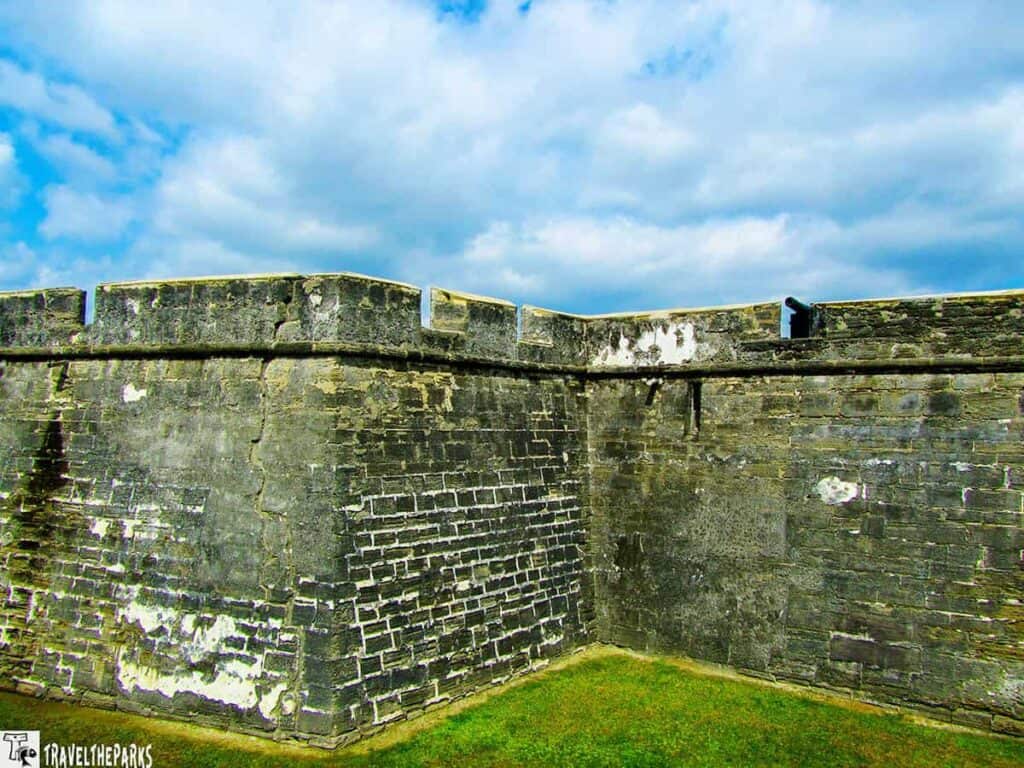
This post may contain affiliate links, meaning if you purchase something through one of these links, we may earn a small commission at no extra cost to you! Read the full disclosure policy here.
Dominated by charming Spanish Colonial–style architecture, St. Augustine is unlike other southern cities, such as Savannah. Spanish conquistador Pedro Menéndez de Avilés founded the city in 1565. St. Augustine is home to an array of historic landmarks that provide glimpses into the city’s past. One such landmark is the Castillo de San Marcos, a 17th-century fortress constructed by the Spanish to protect their interests in the region. It is the oldest masonry fort in the continental United States and offers captivating tours and exhibits. Other notable sites include the Lightner Museum, Flagler College, and the St. Augustine Lighthouse.

Top Things to Do in Historic St. Augustine
Whether you’re a history enthusiast, an art lover, or simply seeking a picturesque coastal getaway, St. Augustine is a destination that truly deserves to be on your radar.
St. Augustine holds the distinction of being the oldest continuously occupied European-established settlement in the United States. It was founded by Spanish explorers in 1565, predating the establishment of Jamestown, Virginia, by several decades. The city’s historical significance is evident in its well-preserved architecture, cobblestone streets, and various landmarks.
Once you arrive in the city, there’s plenty to see and do. We always feel that the best way to immerse yourself in a new place is to walk it. Walking through the streets of St. Augustine feels like stepping back in time. Talk to the locals, as they can usually provide insight into the best dining and attractions. The following travel guide will help get you started in exploring this historic city.
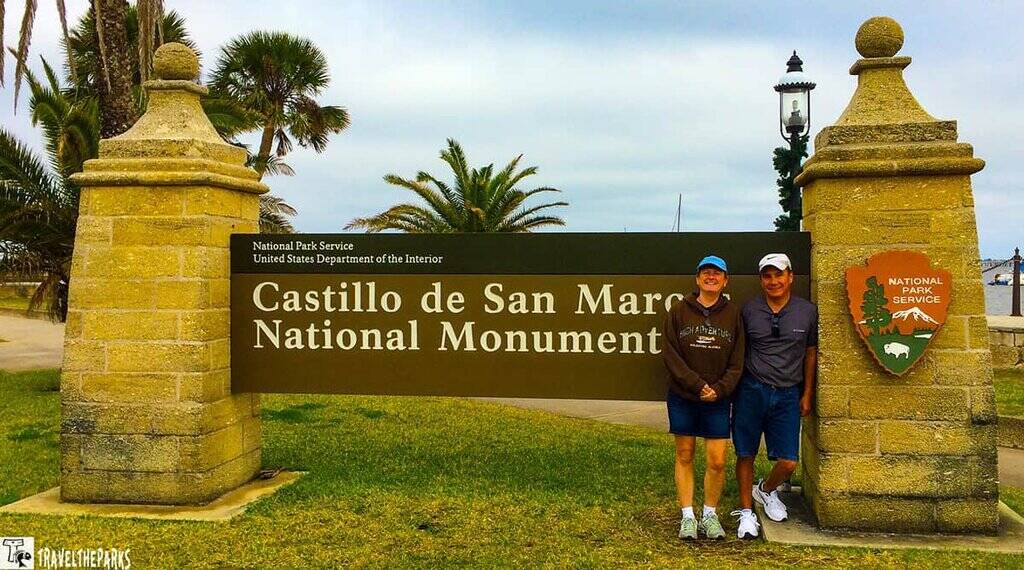
Step Inside the Legendary Fort That Defines St. Augustine’s Past
A true gem, the iconic Castillo de San Marcos, sits in the center of the Historic District on the beautiful shores of Matanzas Bay. It is also the oldest masonry fort in the continental United States. The fort’s architecture is truly unique, especially compared to the other forts we’ve visited, like Fort Malden, Fort Pulaski, and Fort Sumter.
The entrance fee for the Castillo de San Marcos is reasonably priced. Purchasing an America the Beautiful annual pass gains you entrance into all the national parks and monuments and federal recreational lands for one year. While at the fort, try to attend a Ranger-led program and watch either a musket firing demonstration or the firing of the cannons. Don’t forget your passport stamps at the entrance station.
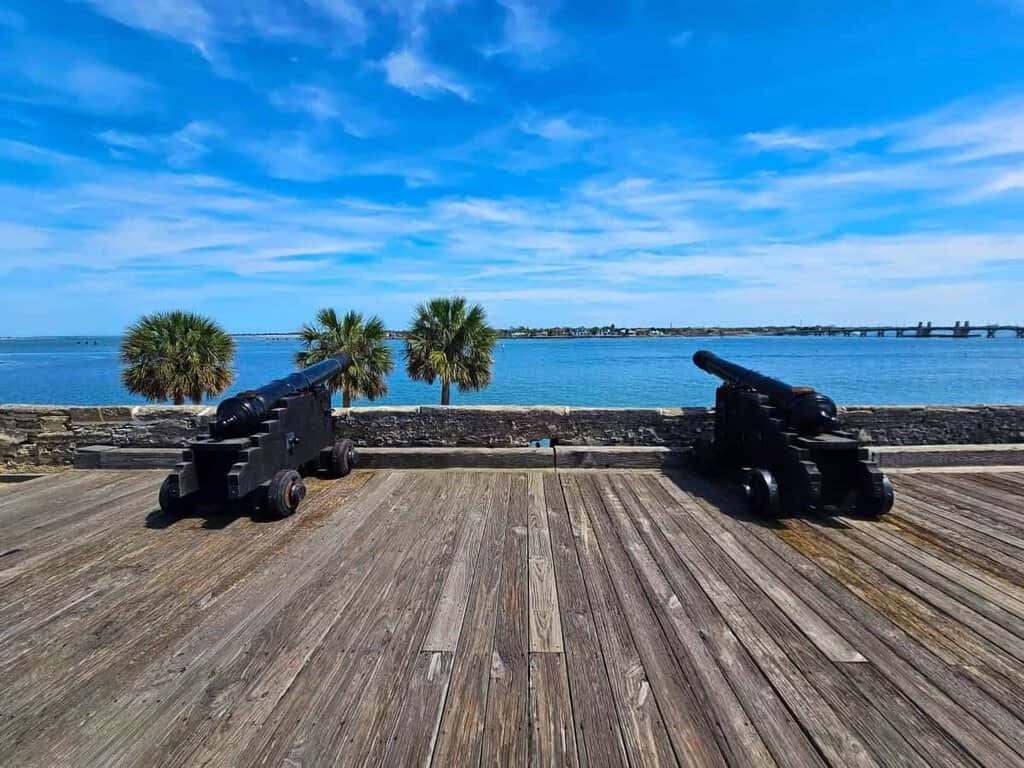
Incredible Stories Behind Castillo de San Marcos
The Spanish originally constructed this bastion-style fortress with coquina in 1672. This unique soft pink limestone most commonly comprises coarse shells and shell fragments and corals cemented together and used for building. The fort took 23 years to complete. Unbeknownst to the architects who designed the fort, coquina can withstand the force of cannon fire. The 18-foot thick walls simply absorbed the cannonball’s fire, which enabled the fort to withstand any attack.
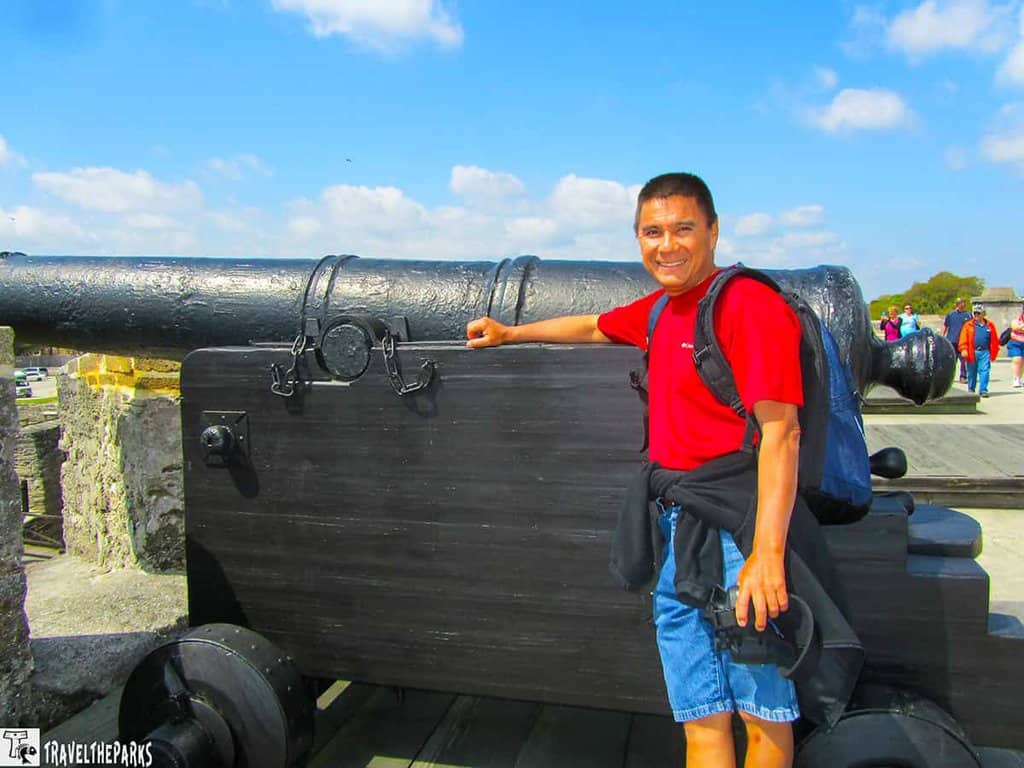
The fort’s design is unique because it has a star shape with bastions at each corner. This design allowed the fort to provide a maximum defense against attacks from all angles. We spent a good part of the day exploring the various levels of the fort, including the gun deck, the officers’ quarters, and the courtyard. The fort also features different exhibits and displays that provided us with information about the history.
One interesting fact is that pirates and the British tried to besiege the fort. They attacked it several times during its history, including by the British in 1702 and 1740. Force never took the fort; the British could never seize the fort in battle.
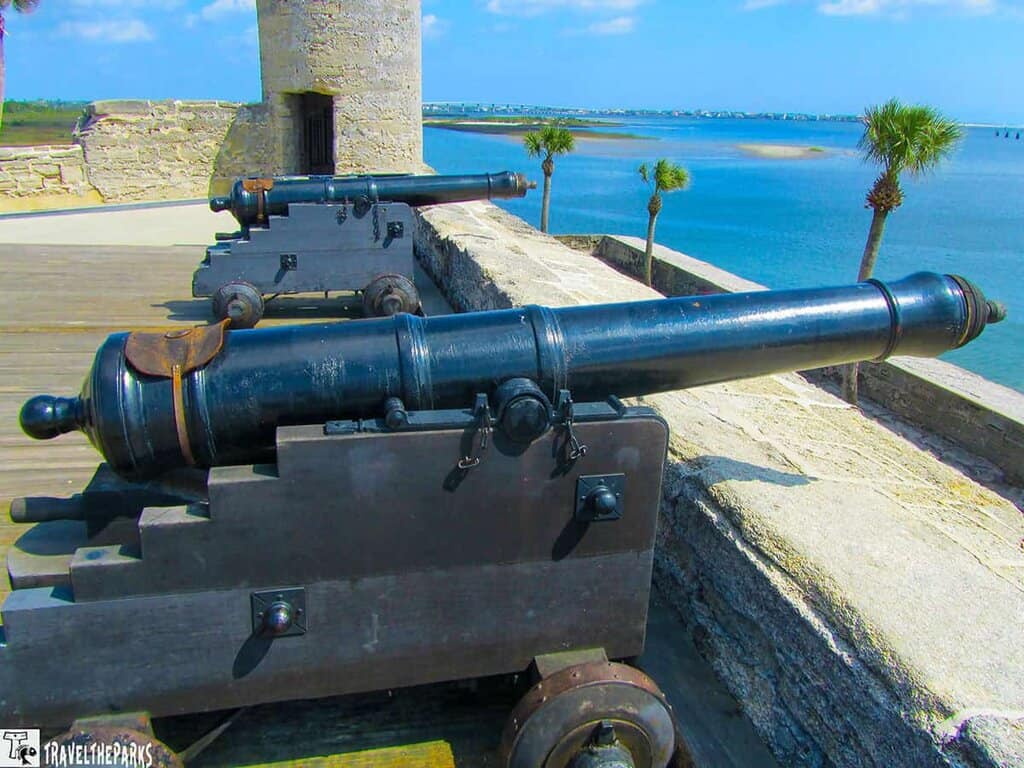
Fort Castillo de San Marcos – It was Never Taken by Force
In 1763, the fort was transferred to British control as part of the Treaty of Paris, which ended the Seven Years’ War. The British renamed the fort-Fort St. Mark and made several modifications to the structure. In 1783, the fort was returned to Spanish control under the terms of the Treaty of Paris that ended the American Revolution.
The United States took control of the fort in 1821, renaming it Fort Marion in honor of General Francis Marion. After the Civil War, it was used as a prison, most notably housing Chief Osceola. Walking the 20-acre site today, it’s hard to imagine enduring Florida’s sweltering summers under such conditions. In 1900, the fort was designated a National Monument, officially recognizing its historical significance.
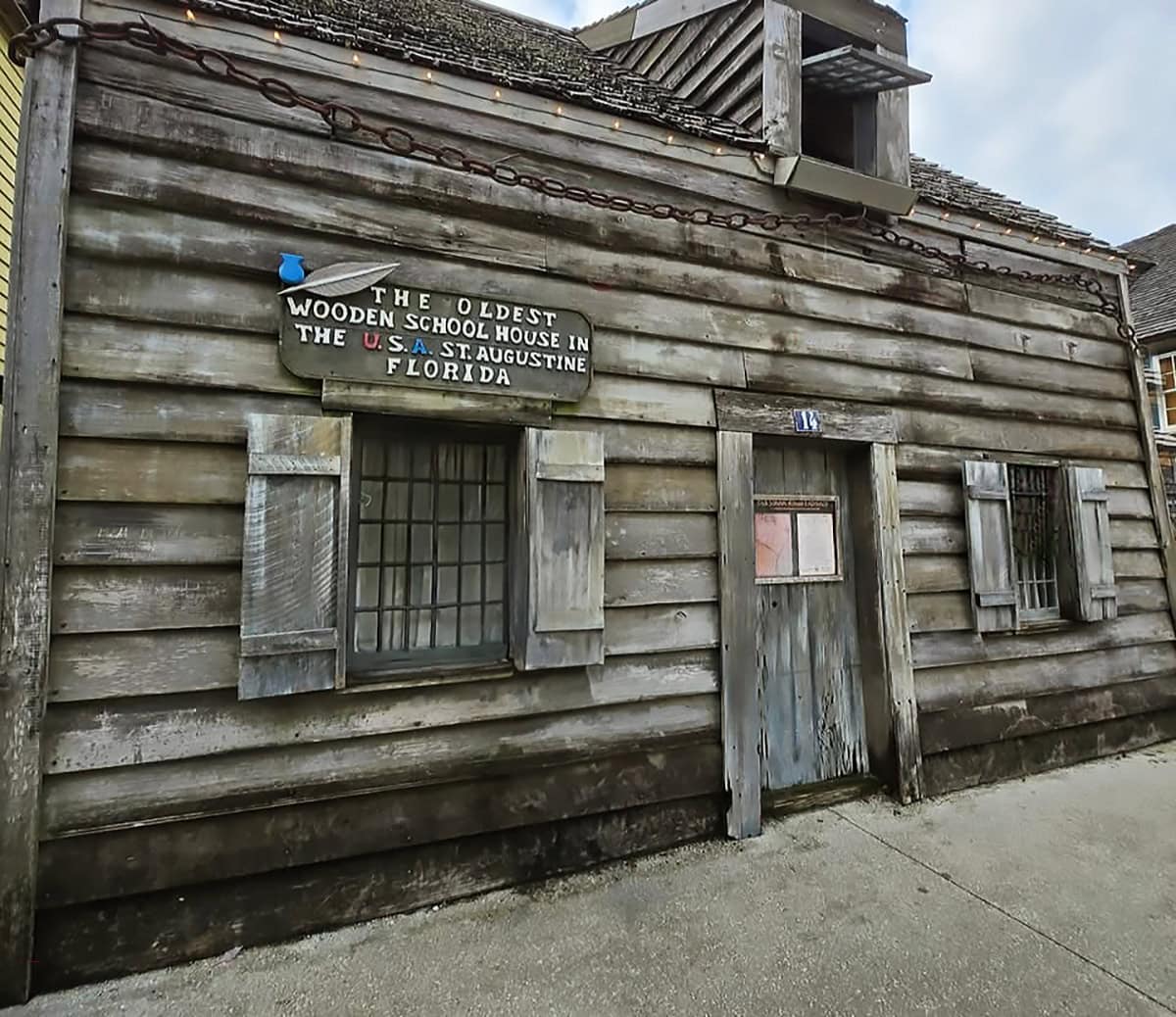
Old Town Trolley: The Easiest Way to Explore Historic St. Augustine
If you don’t feel like walking or have a limited amount of time, try the Old Town Trolley. St. Augustine offers a variety of excellent sightseeing tours, but since we prefer to explore on foot, we started our day with the Hop-On Hop-Off Trolley. This tour provides a great overview of Old Town’s history, while other tour options combine multiple attractions for an additional cost. For those seeking a spookier experience, evening ghost tours are also available!
- The oldest Store Museum Experience- Step back in time to a living history of turn of the century inventions come to life! We loved the goat-powered washing machine.
- Old Jail – check out the gallows and the cell blocks, a look into the working prison of the times.
- St. Augustine History Museum-self-guided tour of 400 years of American history and settlement.
- Fountain of Youth Archaeological Park-not just the fountain of youth, it is an interactive history lesson-enjoy cannon & musket firings, a reconstructed native Timucuan village, and a planetarium.
If you prefer a more romantic tour of Old Town, maybe a horse-drawn carriage is a better mode of transportation.
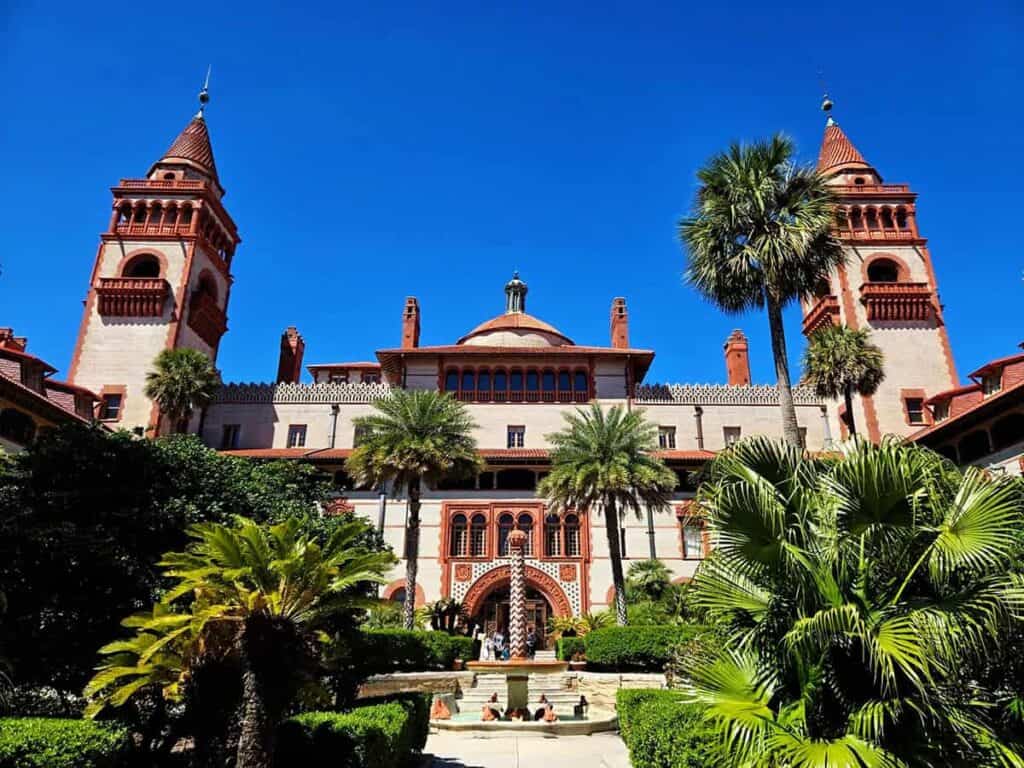
Flagler College: A Stunning Landmark in Legendary St. Augustine
The college was originally the Hotel Ponce de Leon, built by Henry Flagler in 1887, looking to attract wealthy guests that traveled his railroad from the Northeast to Florida. Designed in the neo-Spanish Renaissance style in order to rival the most luxurious hotels of New York, they later converted it into a liberal arts school (Flagler College) in 1967. A tour of this small, private Florida college gives you a glimpse into the life and times of Henry Flagler.
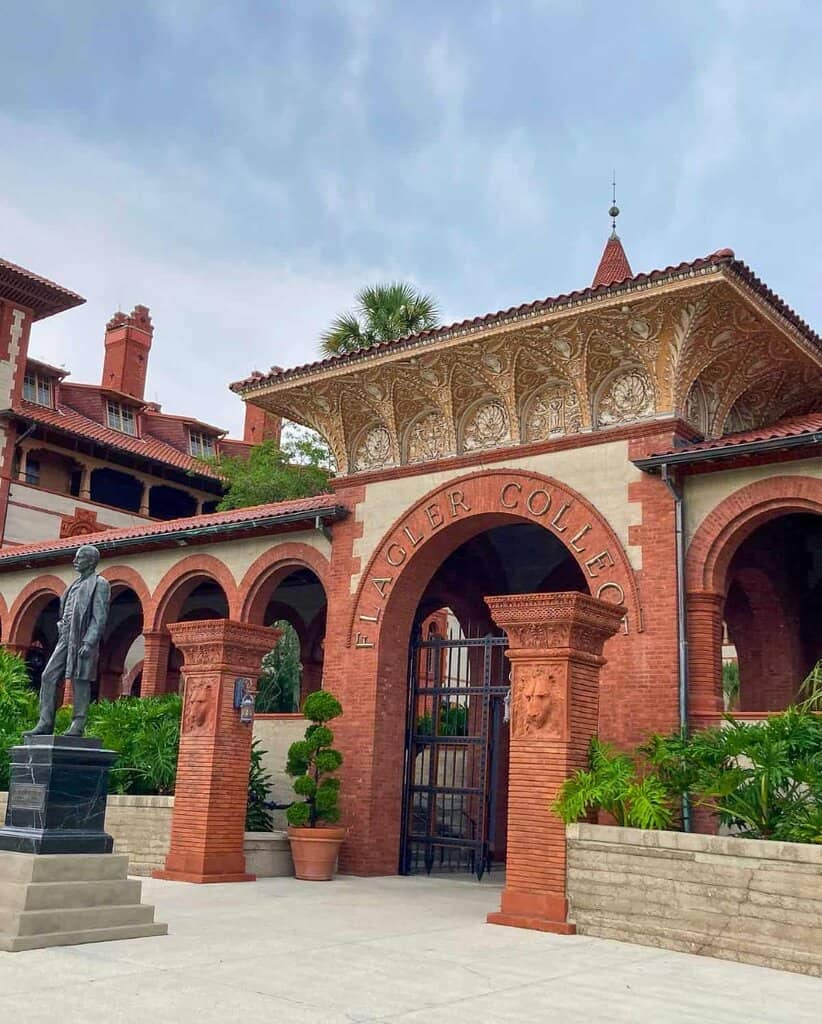
The beauty of the artwork is striking, from the intricate floor tiles and sparkling chandeliers to the stunning Tiffany glass windows. One of the most enchanting details our student guide shared was the painting of Henry Flagler’s wife, Mary Lily Kenan. As you walk past the large portrait, her image appears to age—starting as a young woman on one side of the room and gradually growing older until she is depicted with grey hair on the other side. I love stories like this—they let your imagination truly come alive!
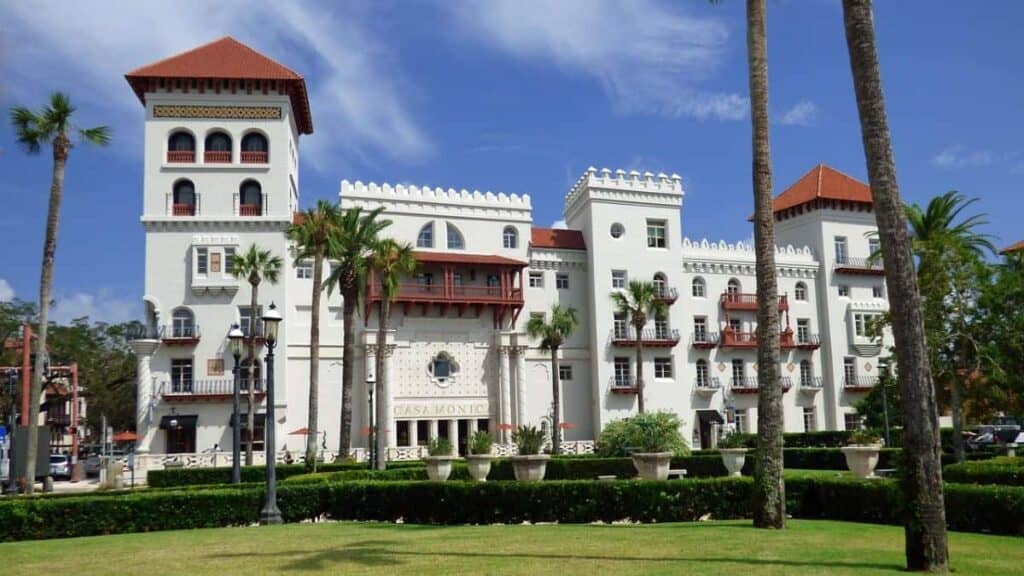
Lightner Museum: A Must-See Treasure in Historic St. Augustine
We toured the quaint Lightner Museum, which was originally the Alcazar Hotel, built by Henry Flagler in 1887. Otto C. Lightner was a publisher from Chicago who purchased the Alcazar in 1946 to house his treasures but later gave the museum to the city of St. Augustine. As we strolled from room to room, we got a feel for how the guests of the Alcazar Hotel must have felt. The museum covers three floors and contains an eclectic collection of Gilded-Age odds and ends. They give you a view of how the wealthy lived. They have preserved the former steam room and therapeutic shower and soaking tub in all its grandeur. The courtyard showcases a beautiful koi pond, fountain and greenery. Very serene.
What was the largest indoor swimming pool in the world has now been converted into a lovely restaurant-Cafe Alcazar. You could easily spend all day walking around this place exploring Lightner’s hodgepodge of artifacts.
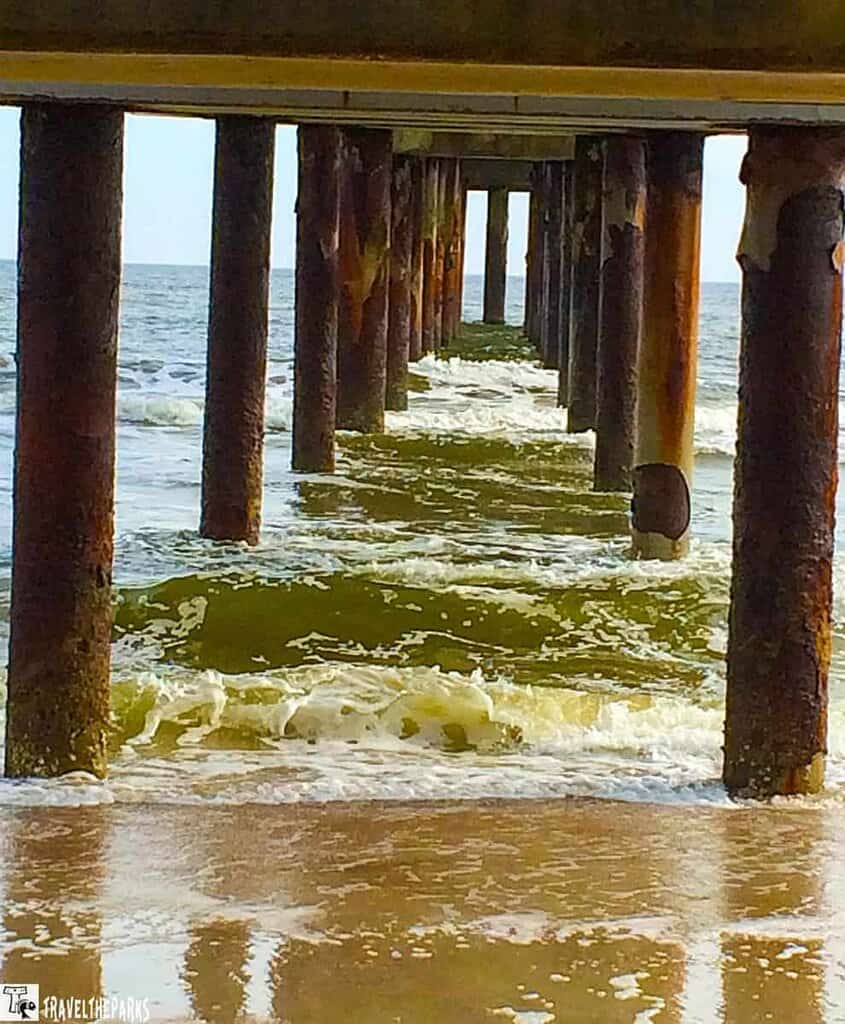
Relax and Recharge at St. Augustine Beach—A Local Favorite
The area is blessed with beautiful stretches of coastline, such as St. Augustine Beach and Anastasia Island State Park. These pristine beaches are perfect for relaxation, swimming, surfing, and sunbathing. No trip to Saint Augustine would be complete if we did not mention a day on the beach. This is one of the best things about St. Augustine is its proximity to the ocean. There are plenty you can visit: Vilano Beach, Crescent Beach, or Anastasia State Park.
We took a brief detour to St. Augustine Beach for the day. The St. Johns County Ocean Pier requires a fee to walk the boardwalk. The public beach has restrooms with outdoor showers, a playground, and picnic tables. We spent a few hours walking the 800 ft. pier watching people fish, took a few photos of surfers, and just enjoyed the sea breeze washing over us.
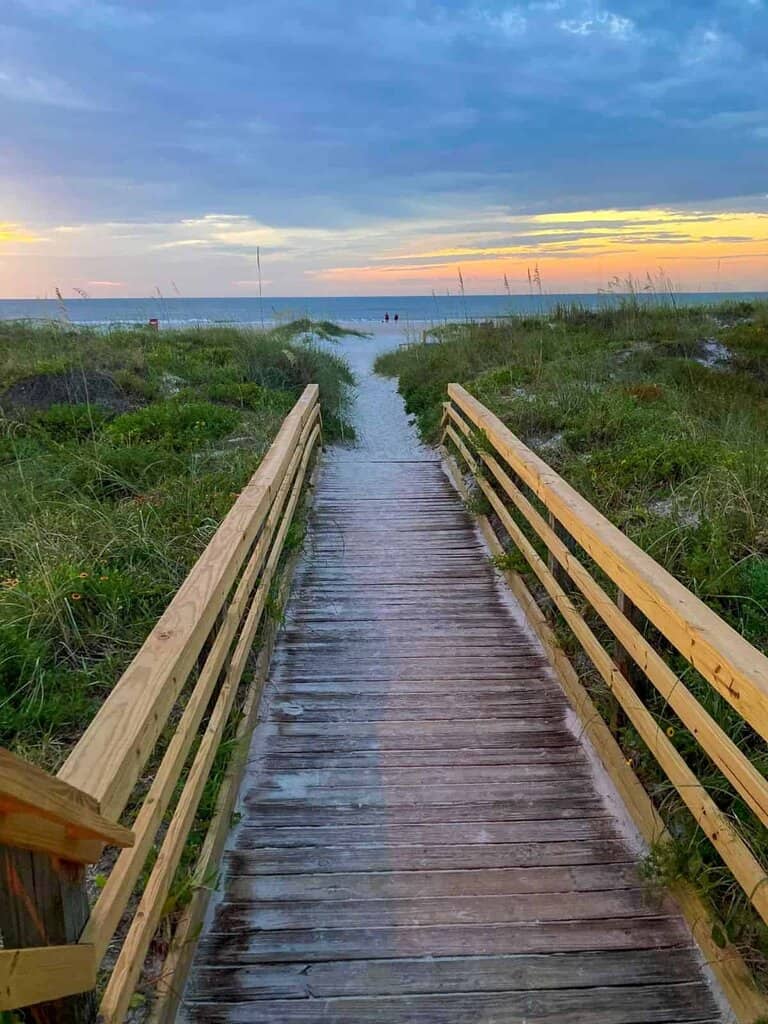
We have been to several beaches in Florida, and Anastasia State Park is one of our favorites, a great place for families or couples. The park has a pristine white-sand beach. You can swim, surf, sunbathe, walk, or bicycle without the worry of vehicles as they are off-limits here. Eco tours and kayaks are also available. For us, we simply love walking in the soft sand along the beach looking for that perfect seashell.

Step Back in Time at the Colonial Quarter – A St. Augustine Must-See
The historic colonial quarter in the old city center is an authentic reenactment of colonial times. I could see why every Florida 4th grader visits this city as part of their educational experience. The Colonial Quarter tells the story of 3 centuries of colonial history. The tiny village is a compilation of small buildings, including a blacksmith, armory, leather, and boat building. Staff offer guided orientation walks as actors in period costume take on the personas of the colonists. Activities abound-kids will love the demonstrations of the cannon, blacksmith shop, and flintlock gun. Afterward, we walked to the many shops on St. George Street. This is the most popular street in the Old Town.
Intrigued by history, we walked the cobblestone streets of St. Augustine, taking the time to read as many of the informational kiosks as possible. Remarkably, St. Augustine had already been a city for 42 years when Jamestown became a settlement. The diverse cultures (Spaniards, British, Native American, African, and American) have all played a role in the history of this city.
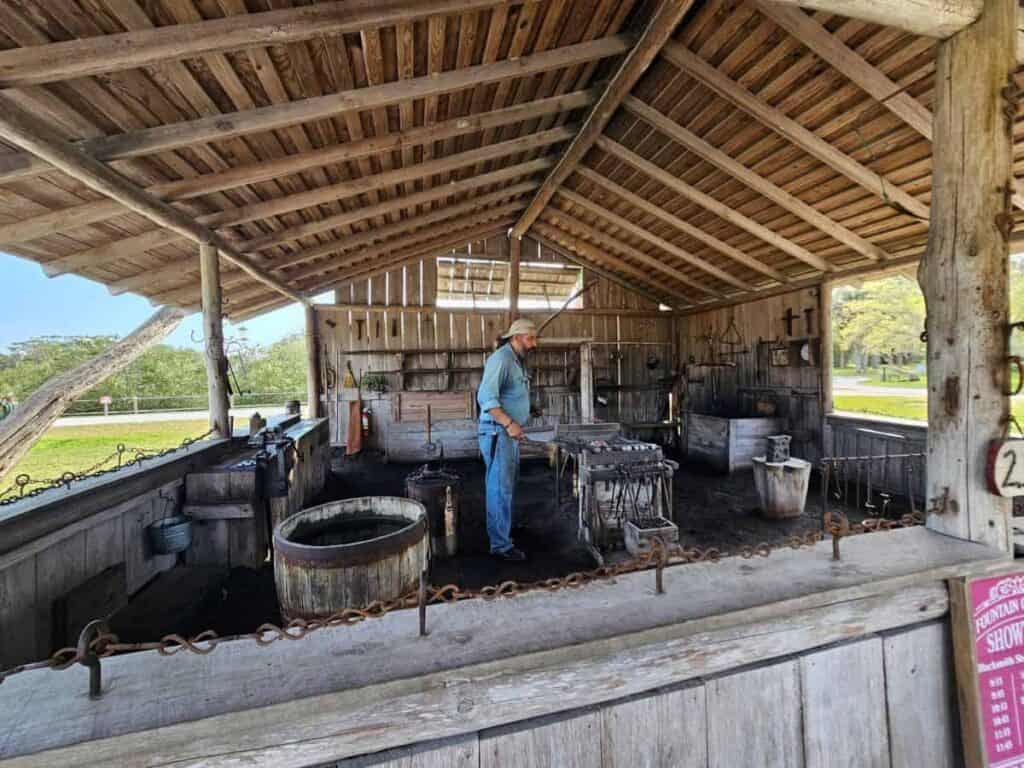
Walk St. George’s Street
St. George Street is a pedestrian-only street in the historic district of St. Augustine, Florida. It is a major tourist attraction and a popular destination for shopping, dining, and entertainment. The street is a must-see for anyone visiting St. Augustine and is a great way to experience the charm and history of this beautiful city.
We found that the street is lined with historic buildings that date back to the 18th and 19th centuries. They have converted many into shops, galleries, and restaurants. Any visitor can find a wide variety of souvenirs, crafts, and local specialties, as well as international cuisine and traditional Florida dishes.
In addition to shopping and dining, St. George Street is home to several historic landmarks, including the Oldest Wooden Schoolhouse, which dates back to the early 18th century, and the Colonial Quarter, a living history museum that recreates life in St. Augustine during the 16th, 17th, and 18th centuries.
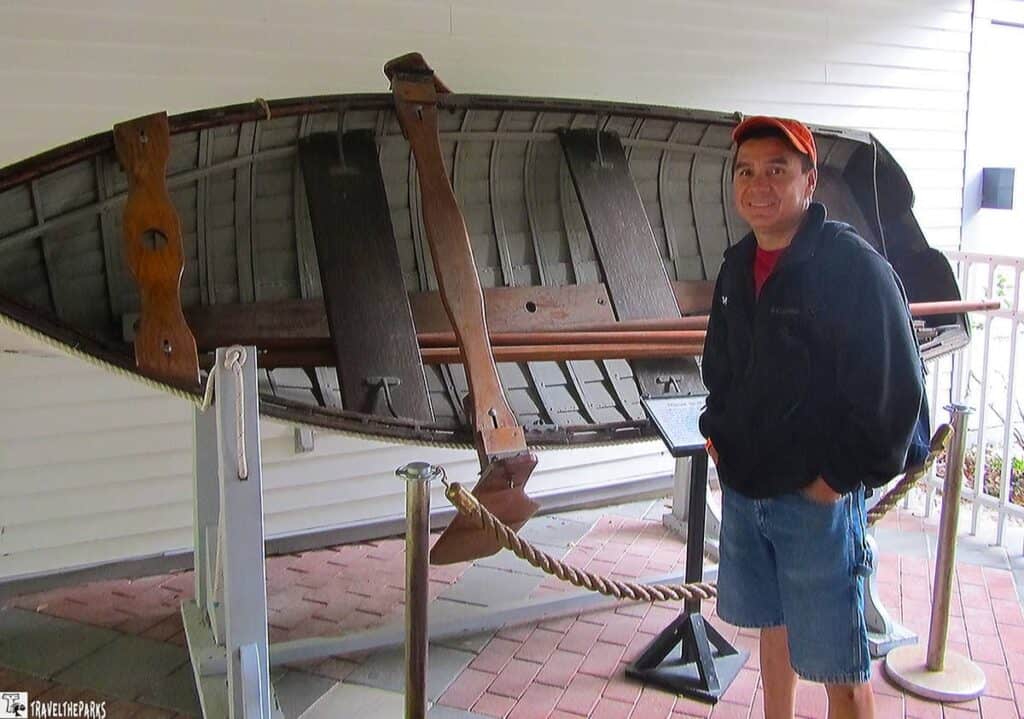
The St. Augustine Lighthouse and Maritime Museum
The museum is dedicated to preserving the history of the lighthouse and the maritime heritage of the region. The museum features exhibits and displays that explore the history of the lighthouse and the maritime culture of St. Augustine. There are hands-on activities for children, guided tours, and special events throughout the year, such as the annual Pirate & Treasure Museum Festival.
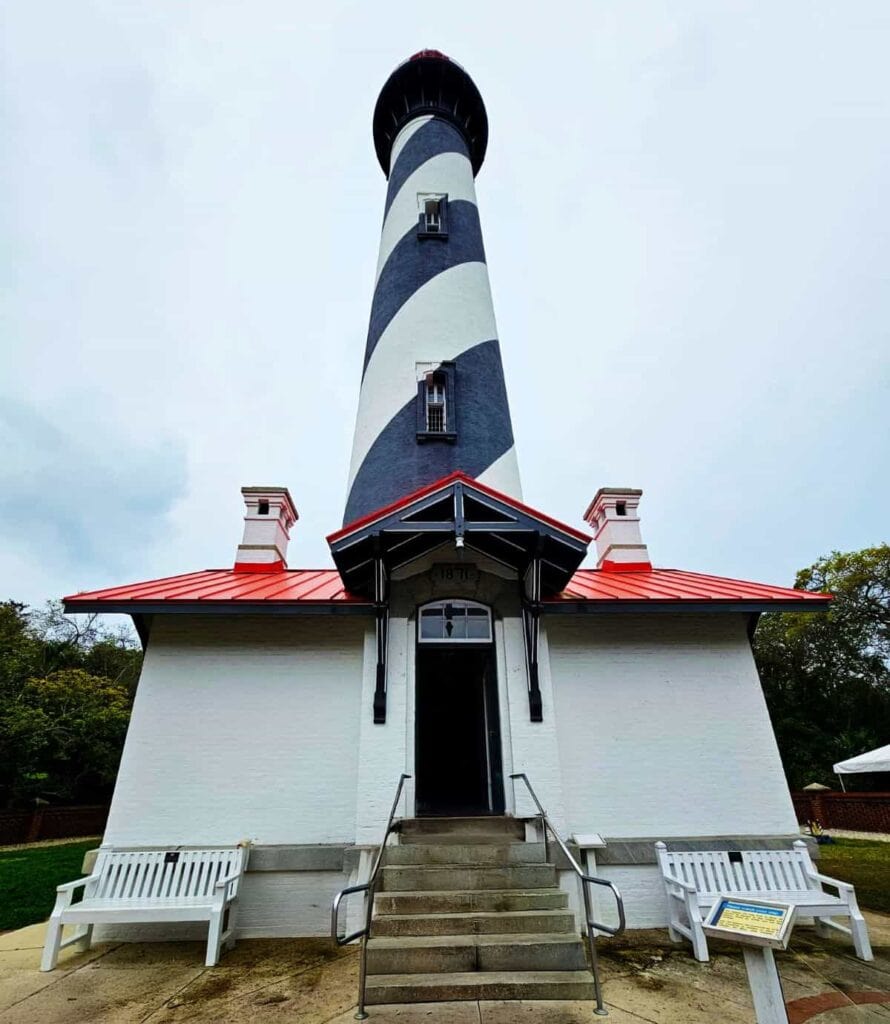
We did a self-guided tour. They built the lighthouse in 1874, and stands 165 feet tall, making it one of the tallest lighthouses in the United States. There are displays of several Fresnel lenses and other historic artifacts. The beautifully restored keeper’s house gave us a glimpse into daily life in the late 1800s. There is also a marine archeological restoration facility on the grounds, and you can see them working with marine artifacts. Luckily, today they are soaking two cannons and removing all the crustaceans using electric currents. It was fascinating to watch.

Climbing to the top of the 219 steps is quite daunting. However, you’ll be rewarded with spectacular views of the Salt Run lagoon. Looking east are the Atlantic Ocean and the beaches. To the west, you see St. Augustine. This is a great way to spend a few hours in the morning.
We’ve visited all three lighthouses—St. Augustine’s historic coastal beacon, Pensacola’s towering Gulf sentinel, and Crooked River’s charming light tucked in Florida’s forested Panhandle—and each offers a distinct and memorable glimpse into maritime history.

Spirits of the St Augustine Distillery
The St. Augustine Distillery is a craft distillery that produces a variety of small-batch spirits using locally sourced ingredients. The distillery is housed in a historic ice plant that dates back to 1917 and has been carefully restored to its original splendor.
This small, locally owned distillery offers a fully guided free tour of the old building that used to be an ice plant. The tour includes a visit to the production area, where visitors can see the stills and other equipment used to make the spirits. The guide helped us to learn about the art of craft distilling. We even got to observe the copper stills and other equipment used to make the spirits. Later, we walked through the barrel room, where the spirits are aged.
Next, the crew prepared wonderful cocktails in the tasting room for us to sample. The distillery also provides a cocktail bar where visitors can enjoy handcrafted cocktails made with the distillery’s spirits. In the adjacent gift store, you are able to purchase gin, vodka, rum, bourbon, and mixers & barware. We purchased a bottle of their smooth bourbon, simply priceless! This place was great.

Supreme San Sebastian Winery Tour
Initially, we thought we would not have time for this tour. However, we found it was possible to take some time for this worthwhile tour of the San Sebastian Winery. The winery is in the heart of downtown St. Augustine and is a great place to spend an afternoon after exploring the historic district, not to mention sampling some of the best wines that Florida offers.
They house the winery in one of Henry Flagler’s old East Coast Railway buildings. This is the sister winery to Lakeridge Winery in Clermont. We find their Southern Red is superb and figured the winery merited a quick tour. The bonus is that the tour of the winery building is free! We enjoyed touring the facility, including the production area and the barrel room.
They offer samples of the various wines that are produced at the winery, including reds, whites, and dessert wines. This informative wine tasting is only $10. We sat with a group of other teachers, toasting March break; it was a fun time. If you can be sure, schedule lunch on the rooftop deck.
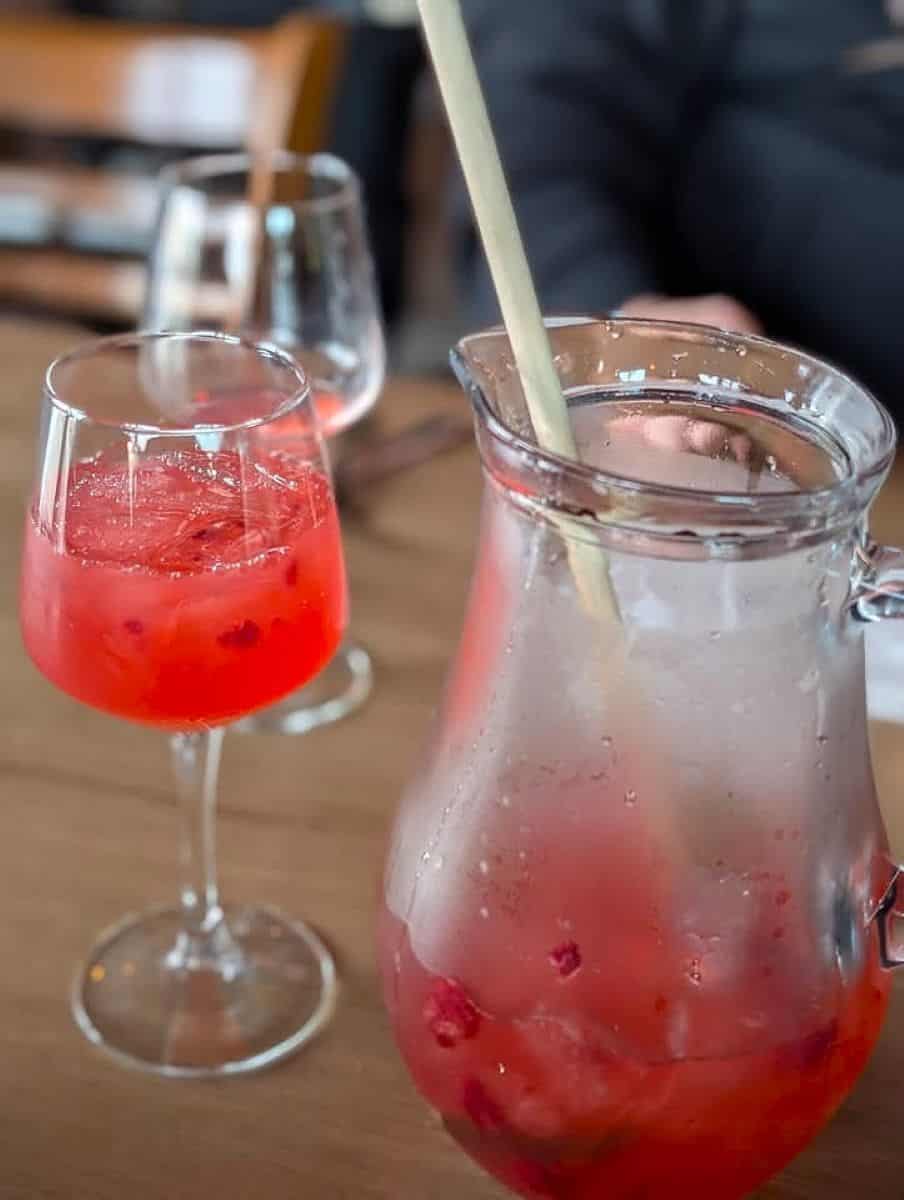
Enjoy the Holiday Season at the Festival Night of Lights
If you have the chance to visit during the holiday season, you will be wowed by the magical Night of Lights. The Bridge of Lions is beautifully lit at night. They wrap every tree along the Riverwalk in a myriad of bright white lights. We walked the ancient city streets in awe of the sheer amount of decorations adorning the shops on St. George Street and the courtyard on the plaza. The Nights of Lights traces its origins to the Spanish Christmas tradition of displaying a white candle in the window. Many travelers, rather than walk, see the trolley as a perfect way to view the lights. Others choose a harbor boat tour as a better option. I prefer to walk the streets, admiring the charm of the old town.

Support conservation efforts at the St. Augustine Reserve
This is a must-do, and we highly recommend it. Our VIP Tour at the St. Augustine Wild Reserve was, hands down, the highlight of our St. Augustine vacation. On the tour, you are typically no further than 5-feet away from the animals, literally front-row! We watched as they showered affection on each of the beautiful animals. The reserve is home to lions, tigers, leopards, pumas, servals, wolves, a lynx, and a couple of hyenas. It is simply amazing watching one of the big cats take a bubble bath or hearing the tiger roar as he awaits his meal. They rescued the animals from neglectful/abusive situations and will spend their lives here. These dedicated volunteers deeply care for and love these animals. My favorite is always watching the wolves. This is a once in a lifetime experience!
The tour lasts a little over two hours and is offered only on Wednesdays and Saturdays, with reservations required. Cameras aren’t allowed, but for $5 you can purchase a CD filled with fantastic photos taken during the tour. The Reserve relies on visitor donations, and they provide a list of needed supplies ahead of your visit. We stopped to pick up a few items from their wish list to help the animals. This tour is truly worth every penny!
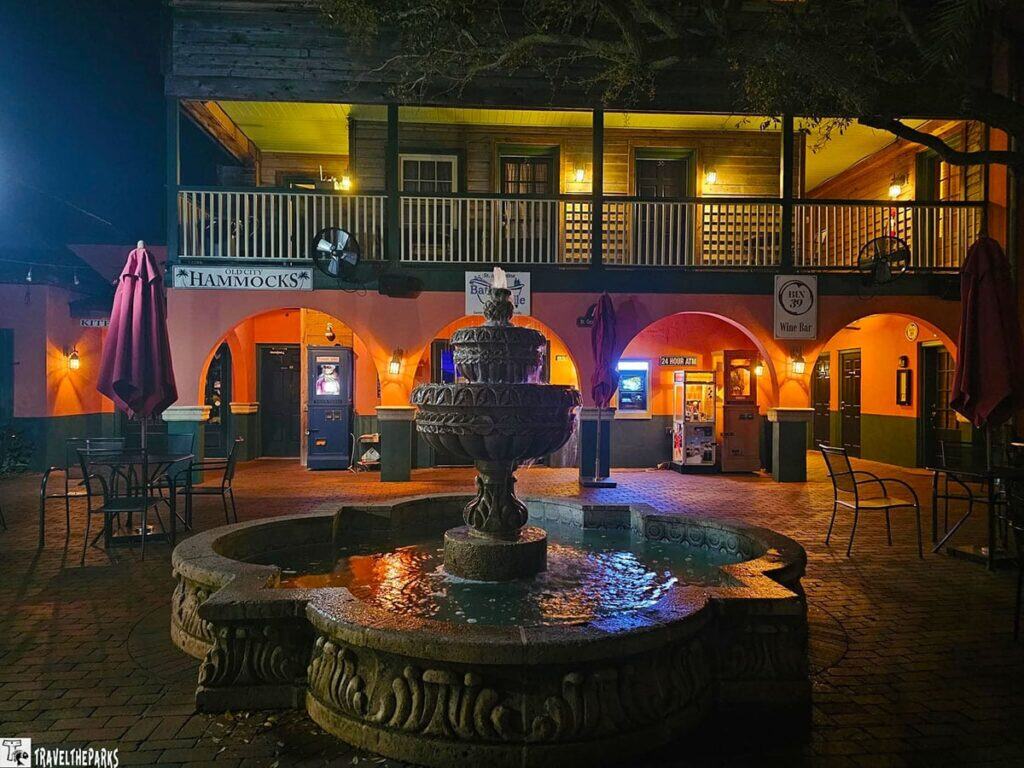
Experience St. Augustine’s Creepy Charm
Ghost tours are one of the unique ways to explore St. Augustine, America’s oldest city, where centuries of history have left behind a trail of mysterious and haunted stories. As you wander the narrow streets, historic squares, and old Spanish corners, guides bring to life tales of colonial settlers, pirates, and lingering spirits that make St. Augustine a favorite for ghost-seekers. If you’re planning a visit, you can use promo code PARKS10 for 10% off select tours. It’s a perfect way for history buffs and thrill seekers alike to experience the city after dark.
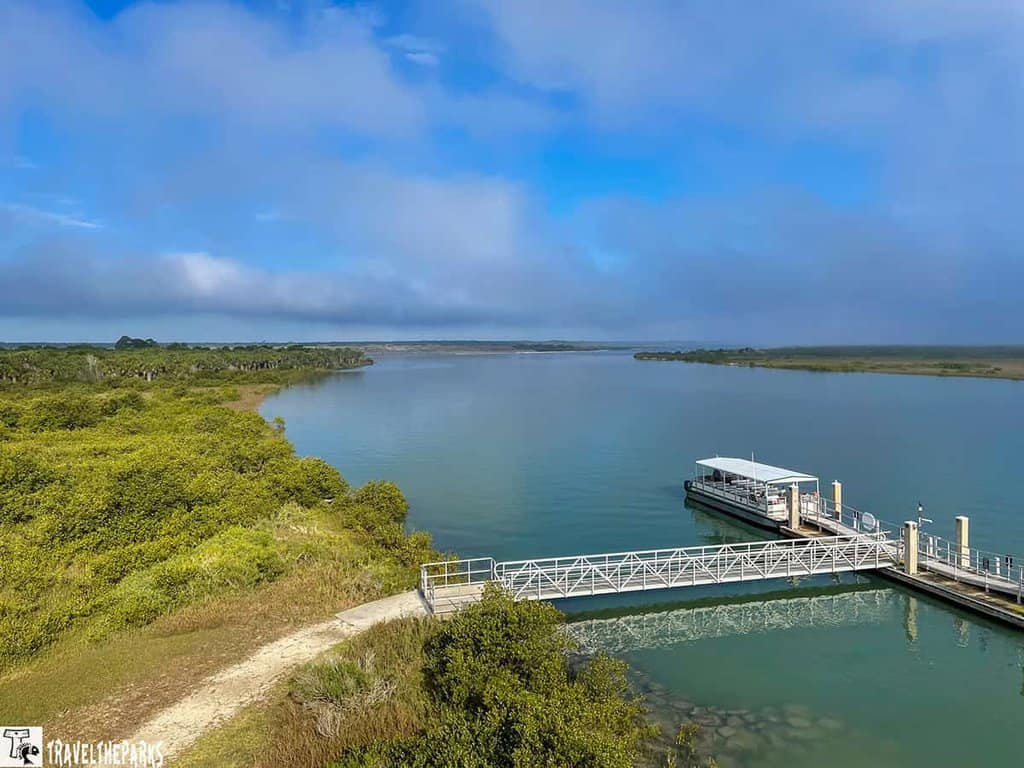
Enhance Your St. Augustine Adventure with a Fort Matanzas Excursion
About 15-miles south of the city, this fort is on Rattlesnake Island in the inter-coastal waterway. The Spanish built Fort Matanzas in 1742. Specifically, to guard the Matanzas Inlet as part of the early warning system to protect the Castillo de San Marcos from being ambushed. At the visitor center, there is a brief video. It gives you an excellent overview of the fort’s history. If you have a National Park Passport Book, you can get your stamp at the visitor center. It is open every day except Christmas, from 9 am to 5:30 pm. And best of all, there is no admission fee. The park protects 299 acres of pristine dunes, marshland, including threatened and endangered species. Be sure to walk the 1/2 mile elevated boardwalk nature trail. Kids can receive Junior Ranger badges and National Passport stamps.
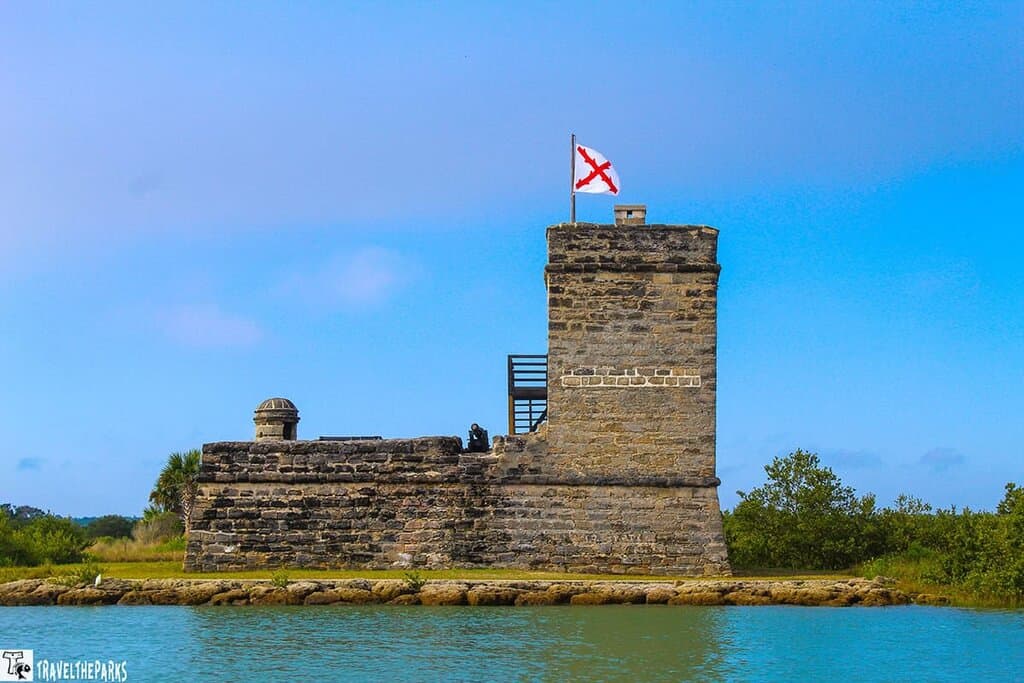
The Park Service boat runs every hour, and the time allowed at the fort is about 30-40 minutes. Once ashore, volunteers in period dress or national park rangers will lead your tour. History buffs will love the brief and informative history of the fort and the re-enactors’ perspective on the life of soldiers stationed in 1742. If you are able, you can climb a ladder through the hatch to the observation deck. Here, there are breathtaking views of Anastasia Island and the Matanzas River. If you are lucky, you may spot dolphins from this vantage point.
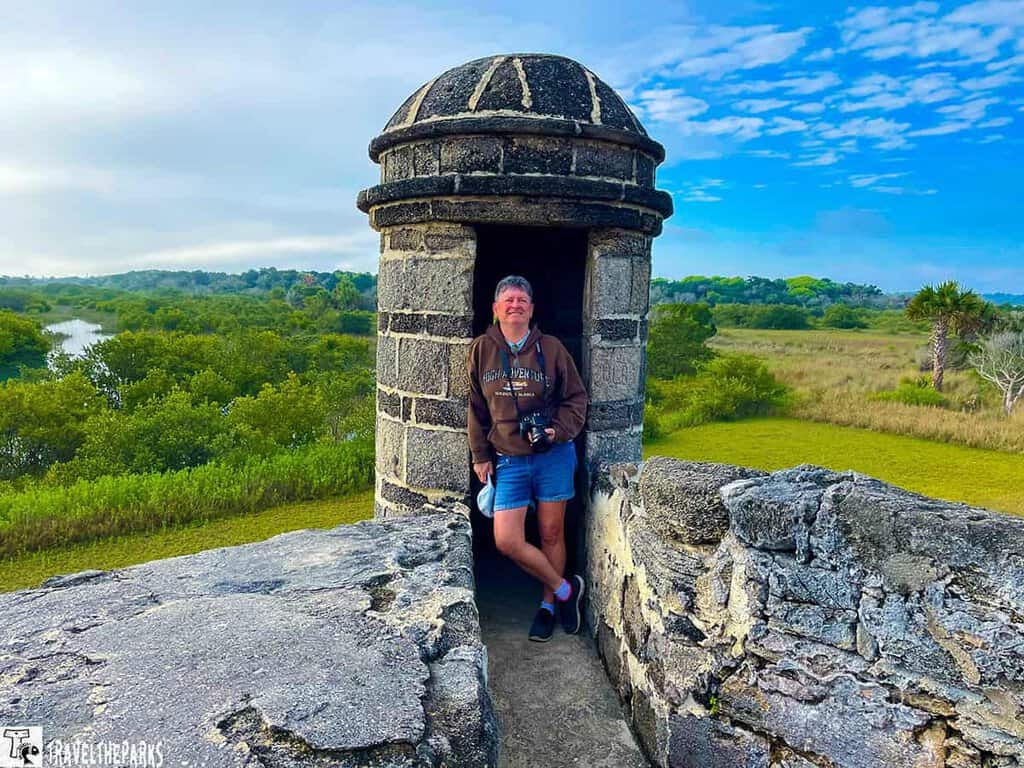
Savor the Flavors of Iconic St. Augustine: Best Dining Spots in Town
St. Augustine is a haven for food lovers, offering a diverse range of culinary experiences. From fresh seafood to farm-to-table delights, the city has an impressive array of restaurants, cafes, and food markets. Visitors can savor local specialties like Minorcan clam chowder and Datil pepper-infused dishes. There is something to suit everyone’s taste. Make sure to look for discount coupons at many of the attractions and restaurants.
- A1A Burrito Works Taco Shop – one of my favorite restaurants on St. George Street!! Nothing fancy, just good old Mexican fare. You get to choose your favorite meal: meat, fish, or veggies, and then add all your favorite toppings. The UFO taco is the best! Very wonderful service.
- Whetstone Chocolates -Incredible gelato-sample some goodies and have a chocolicious day. Would highly recommend the tour.
- Florida Cracker Cafe – A delightful spot for a light lunch! We both had the shrimp po’boy with fries and coleslaw.
- Beaches at Vilano – We enjoyed the Mahi Mahi fish tacos and the island vibe. Enjoy a tropical drink with a marvellous view of the water to watch the sunset.

Where We Dine: Top Dinner Picks in Historic St. Augustine
- Meehan’s Irish Pub – Authentic old-world Irish pub with a gorgeous view of the Bridge of Lions during the Night of Lights. Excellent traditional Irish dishes such as fish n chips, Bangers & Mash, and Shepherd’s Pie.
- Harry Steak & Seafood – We adore Harry’s authentic Cajun cuisine and dine here whenever we are in the city. They have a magnificent array of cocktails and great seafood choices. We sat out on the enclosed patio on our first visit. Although it was a little cool, the outdoor heaters made it comfortable. The jambalaya and crawfish Etouffee, both outstanding, are huge portions. Try the redfish alexandria is my favorite! The crab cakes were delish! Finished with bananas foster, which is a must.
- St. Augustine Fish Camp- They have an extensive menu of local fresh seafood, and that made it hard to choose. We got two appetizers and split a meal (had a late lunch). The food was amazing!! The sangria was delicious. In the late afternoon sun, the view over the water and the cool breeze helped. Loved that it was away from the busy downtown.
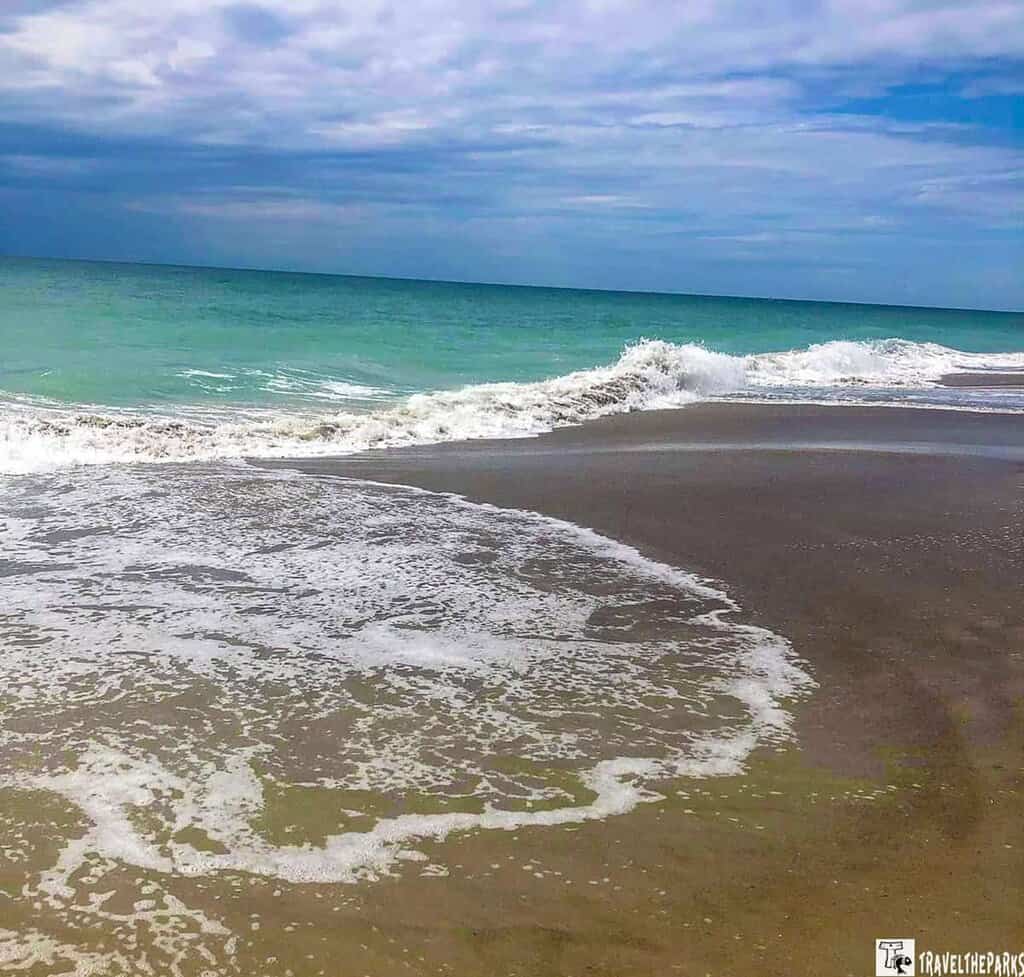
We recommend staying at the Ocean Sands Beach Inn on Vilano Beach. We had an amazing stay. Although not directly in town, I chose this location because it had beach access across the street. Just a few miles from Old Downtown St. Augustine, it is very quaint, cozy, and clean. We have always had flawless check-in, and the free breakfast buffet waffles are delightful.
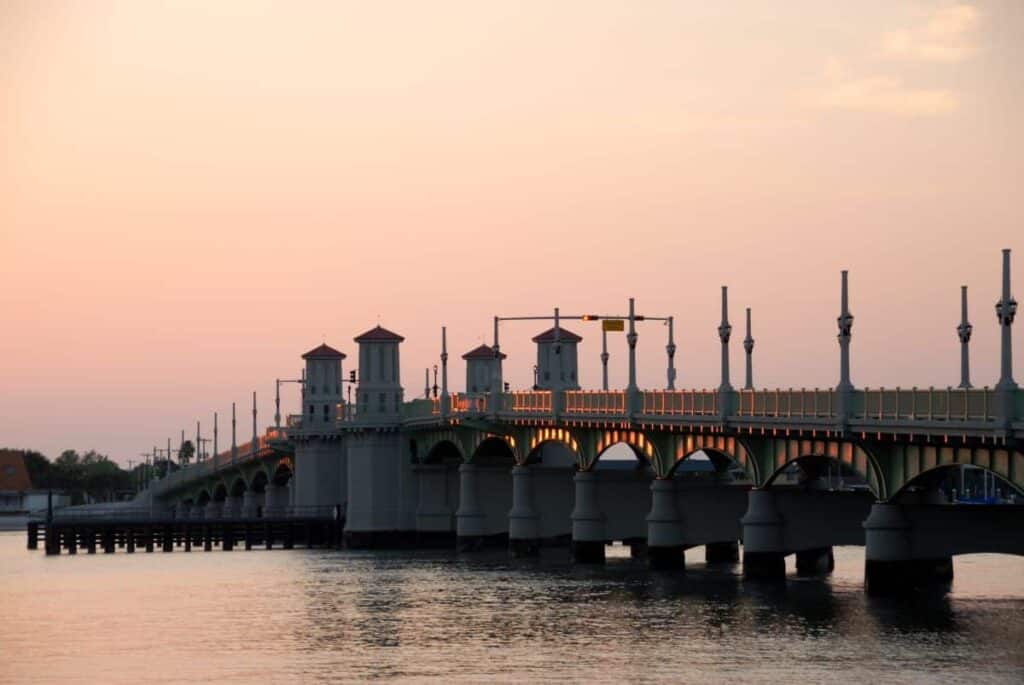
Final Thoughts on Why St. Augustine Needs to Be on Your Radar
We know this beautiful city for its rich history, beautiful architecture, and vibrant cultural scene. There are several compelling reasons why historic St. Augustine deserves to be on your radar.
St. Augustine is easily one of the most charming and exceptional cities in the country. Experience St. Augustine in person and discover its old-world charm. There are so many impressive architectural buildings to explore. Strolling the streets of Old Town, you cannot help falling in love with this city. If you haven’t been to St. Augustine yet, what are you waiting for?
Have you been to this beautiful city? What are some of your favorite things to do? If you have visited, please share with us by commenting below!

![Statue on a stone pedestal with flags and trees in a park. Transcribed Text: JUAN PONCE DE LEON DISCOVERER OF FLORIDA […] MARCH 1513 THIS LAND WHICH HE CALLED LA FLORIDA ESTABLISHING A RIGHT OF POSSESSION UNDER THE SOVEREIGNTY OF THE CROWNS OF SPAIN AND CASTILE FROM WHICH THIS COUNTRY DERIVES THE NAME OF FLORIDA THIS MEMORIAL ERECTED BY PONCE DE LEON’S DESCENDANTS IN THE RICHEST AGRICULTURAL SECTIONS OF SPAIN AUGUST 1909.](https://traveltheparks.com/wp-content/uploads/2020/12/statue-of-ponce-de-leon-st-augustine-1020-FI-1.jpg)
